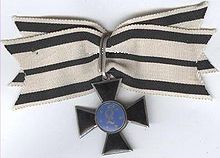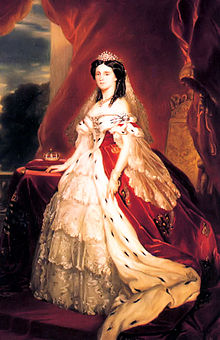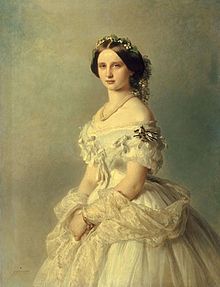- Order of Louise
-
The Order of Louise (German: Luisen-Orden) was founded in 1814 by Frederick William III of Prussia to honor his late wife, the much beloved Queen Luise (née Luise Auguste Wilhelmine Amalie, Herzogin zu Mecklenburg-Strelitz). This order was chivalric in nature, but was intended strictly for women whose service to Germany was worthy of such high national recognition. Its dame companion members were limited to 100 in number, and were intended to be drawn from all classes.
Though the Prussian king was technically the "Sovereign of the Orders" of the realm, the Chief of the Order of Louise was the reigning queen. Daughters in the royal family were invested with this order in lieu of the Order of the Black Eagle, Order of the Red Eagle Grand Cross, Prussian Crown Order First Class, and Royal House Order of Hohenzollern that were reserved for the sons.
The Order of Louise was renewed with each successive king or emperor. It was, thus, issued from its founding in 1814 (during the reign of Friedrich Wilhelm III), renewed in 1850 (during the reign of Friedrich Wilhelm IV), in 1865 (during the reign of Wilhelm I), and in 1890 (during the reign of Wilhelm II).
Contents
Original Statutes
The text of the original royal proclamation that created the Order roughly translates as follows:
When the men of our brave armies bled for the homeland, you found relief in the maintaining care of the women. Faith and hope gave the mothers and daughters of the country the power… for the grand purpose (of the nation). It is impossible to honor or (decorate them enough) for what they have accomplished; but We find it justified to lend them an honor, whose (contributions) are especially acknowledged. We decree therefore hereby following:
1. The honor shall bear the meaningful name:
L u i s e n - O r d e n
Establish that we with this, a small, black-enameled golden cross. The (center medallion) on both sides will be of sky blue enamel; with the letter “L” (on the obverse), surrounded by a wreath of (seven) stars; and on the (reverse) the year “1813/1814”.
2. This order is worn (suspended from) a bow of the white ribbon of the Iron Cross (and shall be worn) on the left breast.
3. The award (will be bestowed) without consideration of social position or rank; however only such persons can receive it, are, who belong to the homeland through birth or marriage, or otherwise nationalized (citizens).
4. The number (of members) is restricted to one hundred.
5. To its selection let's decree hereby a Capitel, which, under the chair of the woman princess Wilhelm Königl. Highness, out of four women …
6. The Capitel will consider candidates, of the feminine sex, from all provinces of the nation, carefully test their credentials, out of which they will decide the worthiest, select up to the available / vacant number (of memberships) and indicate them to Us (the king and emperor) confirmation being specifically reserved for Us. The bestowal / conferral of the award results then, after Our confirmation, under the signature of the Princess Wilhelm Königl. Highness.
7. We hereby order the management of the membership to the (wife of) field marshal count v. d. Gröben.
8. Regarding the loss of the order: We will decide, after considering the expert opinions of the Capitels Allerhöchstselbst, if removal / expulsion should occur, … given general directions, the loss of the order and medal will follow.
Classes of Membership and Insignia
At its initial creation, in 1814, the Order was only available in one class. A second class was added during the reign of Wilhelm I.
Dames, First Class, wore the black-enameled cross with its blue-enameled, medallion centerpiece, suspended from a predominantly white ribbon, with three black stripes, as tied in a bow. Though the statutes indicate that the badge was to be worn on the left breast, many period portraits show the members wearing the badge on or at the left shoulder of their dresses.
Dames, Second Class, wore a similarly-designed silver cross, minus the black enamel, which was also worn suspended from the white and black bow. The Prussian State Handbook of 1907 indicates further variants and subsets of the Second Class of the order: II.1 with silver crown, II.1 (without crown), and II.2.
List of members
The following is a partial list of members compiled from the Prussian State Handbook, from the years 1874 through 1907:
- Alexandrine, Princess of Prussia (1803 - 1892) - daughter of King Friedrich Wilhelm III and Queen Luise; Grand Duchess and consort of Paul Friedrich, Grand Duke of Mecklenburg-Schwerin; mother of Friedrich Franz II, Grand Duke of Mecklenburg-Schwerin
- Elizabeth, Princess of Prussia (1815 - 1885) - daughter of Prince Wilhelm of Prussia; granddaughter of Friedrich Wilhelm II; niece of Friedrich Wilhelm III; cousin of Friedrich Wilhelm IV and Kaiser Wilhelm I; wife of Prince Karl of Hesse and by Rhine; mother of Ludwig IV, Grand Duke of Hesse and by Rhine
- Marie, Princess of Prussia (1825 - 1889) – daughter of Prince Wilhelm of Prussia; cousin of Friedrich Wilhelm IV and Kaiser Wilhelm I; Queen consort of Maximilian II of Bavaria; mother of Ludwig II
- Kaiserin Augusta (nee Augusta Marie Luise Katharina von Sachsen-Weimar-Eisenach, 1811 - 1890)– Chief of the Order, Queen and Empress consort of Kaiser Wilhelm I
- Anna, Princess of Prussia (1836 - 1918) – daughter of Karl, Prince of Prussia; granddaughter of Friedrich Wilhelm III; consort of Landgraf Friedrich Wilhelm of Hesse
- Luise, Princess of Prussia (1838 – 1923) – daughter of Wilhelm I, grand duchess and consort of Grand Duke Friedrich I of Baden; Dame Grand Cross
- Princess Josephine of Baden – consort of Sovereign Prince Karl Anton of Hohenzollern
- Kaiserin Victoria (1840 - 1901)– daughter of Queen Victoria and Prince Albert of Great Britain; Princess Royal of Great Britain; consort of Kaiser Friedrich III
- Charlotte, Princess of Prussia (1860 - 1919) – oldest daughter of Friedrich III, consort of Bernhard III of Saxe-Meiningen
- Viktoria, Princess of Prussia (1866 - 1929) – second daughter of Friedrich III; consort of Prince Adolf of Schaumburg-Lippe
- Sophie, Princess of Prussia (1870 - 1932) – third daughter of Friedrich III; Queen consort of King Constantine I of Greece
- Margarethe, Princess of Prussia (1872 - 1954) – youngest daughter of Friedrich III; consort of Friedrich Karl, Prince and Landgrave of Hesse
- Luise Margarethe, Princess of Prussia (1860 - 1917) – daughter of Friedrich Karl, Prince of Prussia; great-granddaughter of Friedrich Wilhelm III; Duchess of Connaught as wife and consort of Prince Arthur of Great Britain, Duke of Connaught and Strathearn
- Alexandrine, Princess of Prussia (1842 - 1892) – daughter of Prince Albrecht (1809 - 1872) and Marie, sister of Prince Albrecht (1837 - 1906)
- Princess Marie of Saxe-Altenburg (1854 - 1898) – daughter of Ernst I, Duke of Saxe-Altenburg; wife of Prince Albrecht of Prussia (1837 - 1906)
- Kaiserin Augusta Victoria (1858 - 1921)– Chief of the Order, consort of Wilhelm II
- Luise Sophie von Schlesweig-Holstein (1866 - 1952) – wife of Friedrich Leopold, Prince of Prussia; sister of Empress Augusta Victoria
- Irene von Hessen – wife of Prince Heinrich of Prussia; sister-in-law of Wilhelm II
- Viktoria Margarethe, Princess of Prussia (1890 - 1923) – daughter of Friedrich Leopold; great-great-granddaughter of Friedrich Wilhelm III
- Viktoria Luise, Princess of Prussia (1892 - 1980) – only daughter of Wilhelm II; Grand Duchess and consort of Ernst August, Herzog von Braunschweig und Luneberg (Duke of Brunswick)
- Cecile of Mecklenburg-Schwerin (1886 - 1954) – wife and Crown Princess of Crown Prince Wilhelm of Prussia; daughter-in-law of Wilhelm II
- Sophie Charlotte von Oldenburg (1879 - 1964) – wife of Prince Eitel Friedrich of Prussia
- Maria, Princess of Hohenzollern-Sigmaringen (1845 - 1912) – daughter of Sovereign Prince Karl Anton of Hohenzollern-Sigmaringen; sister of Sovereign Prince Leopold of Hohenzollern; wife of Prince Philippe of Belgium, Duke of Flanders; mother of Albert I, King of the Belgians
- Antonia, Infanta of Portugal (1845 - 1913) – consort of Sovereign Prince Leopold of Hohenzollern
- Elizabeth, Princess of Wied (1843 - 1916) – wife of Karl, Prince of Hohenzollern; sister-in-law of Sovereign Prince Leopold of Hohenzollern-Sigmaringen; Luisen-Orden RmK1 (with Br)
- Luise, Princess of Thurn & Taxis (born 1859) – wife of Friedrich, Prince of Hohenzollern-Sigmaringen; sister-in-law of Sovereign Prince Leopold of Hohenzollern
- Maria Teresa di Borbone, Princess of the Two Sicilies (1867 - 1909) – daughter of Prince Louis, Count of Trani; consort of Sovereign Prince Wilhelm of Hohenzollern-Sigmaringen
- Josefine, Princess of Belgium (born 1872) – daughter of Prince Philippe of Belgium, Duke of Flanders, and Maria, Princess of Hohenzollern-Sigmaringen, Duchess of Flanders; wife of Karl Anton, Prince of Hohenzollern-Sigmaringen
Sources
- Gottschalck, Friedrich. Almanach der Ritter-Orden. Leipzig, (Kingdom of) Saxony: Georg Joachim Goeschen, 1819.
- Handbuch über den Königlich Preußischen Hof und Staat für das Jahr 1874. Berlin: Kingdom of Prussia, 1873.
- Handbuch über den Königlich Preußischen Hof und Staat für das Jahr 1883. Berlin: Kingdom of Prussia, 1882.
- Handbuch über den Königlich Preußischen Hof und Staat für das Jahr 1907. Berlin: Kingdom of Prussia, 1906.
Orders and decorations of the Kingdom of Prussia Order of the Black Eagle • Order of the Red Eagle • House Order of Hohenzollern • Order of the Crown • Johanniter Order • Order of Louise • Pour le Mérite •
Wilhelm-Orden •Order of Merit of the Prussian Crown • Ladies Merit Cross • Cross of Merit for Women and Girls • Kulm Cross • Iron Cross • Gold Cross of Merit of the Military Categories:
Categories:- 1814 establishments
- Orders, decorations, and medals of Prussia
- Orders of knighthood of Germany
- Orders of knighthood for women
- Kingdom of Prussia
- Order of Louise
Wikimedia Foundation. 2010.






